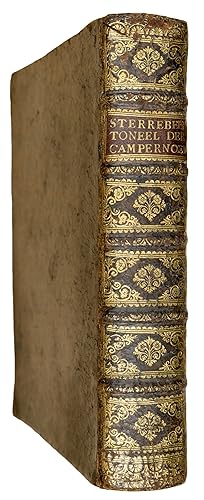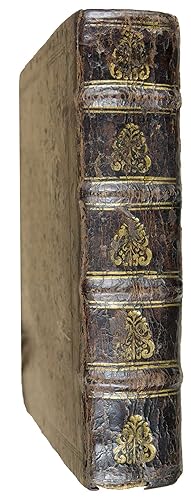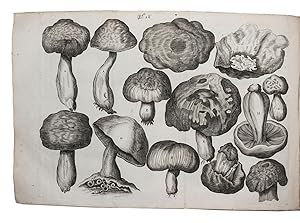theatrum fungorum von van sterbeeck (3 Ergebnisse)
Produktart
- Alle Produktarten
- Bücher (3)
- Magazine & Zeitschriften
- Comics
- Noten
- Kunst, Grafik & Poster
- Fotografien
- Karten
-
Manuskripte &
Papierantiquitäten
Zustand
- Alle
- Neu
- Antiquarisch/Gebraucht
Einband
- alle Einbände
- Hardcover (2)
- Softcover
Weitere Eigenschaften
- Erstausgabe
- Signiert
- Schutzumschlag
- Angebotsfoto
Land des Verkäufers
Verkäuferbewertung
-
Theatrum Fungorum oft het tooneel der Campernoelien. Waer inne vertoont wort de gedaente, ken-teeckens, natuere, crachten, voetsel, deught ende ondeught; mitsgaders het voorsichtigh schoonmaken ende bereyden van alderhande Fungien.
Anbieter: Antiquariaat Junk, Amsterdam, Niederlande
Erstausgabe
Antwerpen, Joseph Jacobs, 1675. 4to (198 x 160mm). pp. (38), 396, (20), with engraved frontispiece, 1 folded engraved portrait and 36 (many folded) engraved plates. Contemporary calf, richly gilt ornamented spine in 6 compartments with gilt lettered red label (tiny tear at head of spine). Scarce first edition, a reissue appeared 1712. "First edition of the first separate general work on fungi, describing edible and poisonous varieties. L'Escluse has done a study called 'Fungorum in Pannonis Observatorum Historia' which was first published as part of his 'Rariorum Plantarum Historia', 1601. However, according to Nissen, L'Escluse's original manuscript for this treatise with its eighty-seven original drawings had been lost by the publisher, so they had to use other illustrations for the 1611 edition, and these were quite inaccurate. Afterwards the lost manuscript reappeared and Sterbeeck used it as a basis for his work, adding much new material of his own" (Hunt 341)."Frans van Sterbeeck, a Flemish priest of noble extraction, was born and died in Antwerp where he lived for the greater part of his life. During the eight years following his ordination in 1655, while suffering from a chronic illness, he returned his attention to botany, with particular reference to fungi and soon became a recognized expert. He was on friendly terms with other Flemish botanists and in May 1663 was visited by John Ray who admired the rare plants in van Sterbeeck's garden. It was in 1672 that Adriaan David, an Antwerp pharmacist and amateur botanist (he contributed a sonnet to the collection of adulatory tributes to the author which prefaces the 'Theatrum fungorum'), took the celebrated 'Code de l'Éscluse' (then owned by Dr. Syen, professor of botany at Leiden University) to van Sterbeeck who made considerable, if somewhat surreptitious, use of it as a source of illustrations for ther 'Theatrum fungorum' in which he claimed to have based all but a few figures on direct observation from nature" (Ainsworth, Introduction to the history of mycology pp 48-49). The manuscript was lost again for a period of 2 hundred years and is now in the Leiden University library.The elaborate frontispiece shows baskets full of mushrooms and in the middle of a crowd most probably van Sterbeeck picking a mushroom out of a basket.Very clear and strong impressions of the plates.Hunt 341; Nissen BBI, 1892.; Hortus Belgicus 34.
-
Theatrum Fungorum oft het tooneel der Campernoelien. Waer inne vertoont wort de gedaente, ken-teeckens, natuere, crachten, voetsel, deught ende ondeught; mitsgaders het voorsichtigh schoonmaken ende bereyden van alderhande Fungien.
Anbieter: Antiquariaat Junk, Amsterdam, Niederlande
Erstausgabe
Antwerpen, Joseph Jacobs, 1675. 4to (200 x 155mm). pp. (38), 396, (20), with engraved frontispiece, 1 folded engraved portrait and 36 (many folded) engraved plates. Contemporary calf, richly gilt ornamented spine in 5 compartments (splits to upper joints, but firm). Scarce first edition, a reissue appeared 1712. "First edition of the first separate general work on fungi, describing edible and poisonous varieties. L'Escluse has done a study called 'Fungorum in Pannonis Observatorum Historia' which was first published as part of his 'Rariorum Plantarum Historia', 1601. However, according to Nissen, L'Escluse's original manuscript for this treatise with its eighty-seven original drawings had been lost by the publisher, so they had to use other illustrations for the 1611 edition, and these were quite inaccurate. Afterwards the lost manuscript reappeared and Sterbeeck used it as a basis for his work, adding much new material of his own" (Hunt 341)."Frans van Sterbeeck, a Flemish priest of noble extraction, was born and died in Antwerp where he lived for the greater part of his life. During the eight years following his ordination in 1655, while suffering from a chronic illness, he returned his attention to botany, with particular reference to fungi and soon became a recognized expert. He was on friendly terms with other Flemish botanists and in May 1663 was visited by John Ray who admired the rare plants in van Sterbeeck's garden. It was in 1672 that Adriaan David, an Antwerp pharmacist and amateur botanist (he contributed a sonnet to the collection of adulatory tributes to the author which prefaces the 'Theatrum fungorum'), took the celebrated 'Code de l'Éscluse' (then owned by Dr. Syen, professor of botany at Leiden University) to van Sterbeeck who made considerable, if somewhat surreptitious, use of it as a source of illustrations for ther 'Theatrum fungorum' in which he claimed to have based all but a few figures on direct observation from nature" (Ainsworth, Introduction to the history of mycology pp 48-49). The manuscript was lost again for a period of 2 hundred years and is now in the Leiden University library.The elaborate frontispiece shows baskets full of mushrooms and in the middle of a crowd most probably van Sterbeeck picking a mushroom out of a basket.Very clear and strong impressions of the plates.Hunt 341; Nissen BBI, 1892.; Hortus Belgicus 34.
-
Theatrum fungorum, oft het tooneel der campernoelien waer inne vertoont wort de gedaante, ken-teeckens, natuere, crachten, voetsel, deught ende ondeught.Antwerp, Joseph Jacobs, 1675. 4to. With folding engraved portrait of the dedicatee (the Antwerp city physician Joh. van Buyten) by Arn. van Westerhout after Car. E. Biset, and 36 mostly folding engraved plates by P. van Sickeleers. Contemporary vellum.
Anbieter: Antiquariaat FORUM BV, Houten, Niederlande
Erstausgabe
[38], 396 pp.First edition of the earliest Dutch monograph on fungi, by Franciscus van Sterbeeck (1630-1693), a Flemish clergyman, botanist and mycologist. Clusius had done research on fungi at the end of the 16th century, and published the results as part of his Rariorum plantarum historia in 1601. However, Clusius's original manuscript for this part, together with his 87 original drawings, had been lost. Accordingly, the publisher had to use other (and rather inaccurate) illustrations for the 1601 edition. Afterwards, the lost manuscript reappeared, and Sterbeeck used it as a basis for his own work, adding much new material. All species of toadstools and mushrooms are treated in detail, with descriptions of their natural history, as well as their gastronomic and medical properties. The work includes observations on wild growing fruits, nuts, roots, herbs etc. Of special interest are the remarkably fine plates, realistically illustrating a large number of fungi and wild fruits. Lacking the frontispiece and the 10 leaves of the Index at the end. Binding slightly soiled and damaged. The author presented this copy in 1682 to the Capuchin Friars of the monastery at Tervuren near Brussels. A rare and beautiful book.l Myko Libri 2050; Nissen, BBI 1892; Pritzel 8947; Stafleu & Cowan 13.012; cf. Willebrands & Van 't Hoog (eds.), Traktaat van de kampernoeljes, genaamd duivelsbrood (Hilversum 2006).




